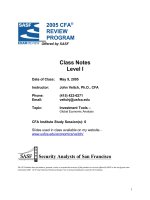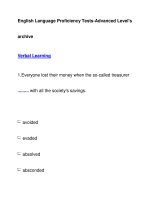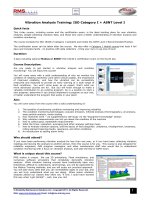Level i learning objectives 2018
Bạn đang xem bản rút gọn của tài liệu. Xem và tải ngay bản đầy đủ của tài liệu tại đây (152.42 KB, 9 trang )
Learning Objectives
CMT Level I - 2018
An Introduction to Technical Analysis
Section I: Chart Development and Analysis
Chapter 1
The Basic Principle of Technical Analysis - The Trend
By the end of this chapter you should be able to:
Define what is meant by a trend in technical analysis
Explain why determining the trend is important to analysts
Identify primary, secondary, short-term, and intraday trends
Describe the basic beliefs behind the art of technical analysis
Chapter 2
Dow Theory
By the end of this chapter you should be able to:
Describe the history of the development of Dow Theory
Identify the basic principles of Dow Theory
Recognize three types of trends identified in Dow Theory: primary, secondary
and minor
Explain the concept of confirmation in Dow Theory
Explain the role of volume in Dow Theory
Chapter 3
History and Construction of Charts
By the end of this chapter you should be able to:
Explain the advantages of reviewing price information in chart format
Identify how to construct several types of charts including line, bar, and
candlestick
Identify the differences between arithmetic and logarithmic scales
© 2018 CMT Association, Inc.
Chapter 4
Trends – The Basics
By the end of this chapter you should be able to:
Explain why trend identification is important to achieve profits
Recognize an uptrend, a downtrend, and a trading range
Describe the concept of support and resistance
Identify trends using most common methods
Identify significant reversal points
Chapter 5
Breakouts, Stops and Retracements
By the end of this chapter you should be able to:
Describe and identify a breakout
Recognize the signals that identify breakouts
Explain the purpose of entry and exit stops
Describe methods for setting entry and exit stops
Chapter 6
Moving Averages
By the end of this chapter you should be able to:
Identify trends with moving averages
Recognize methods for calculating simple and exponential moving averages
Describe and interpret directional movement indicators
Identify characteristics of envelopes, channels and bands
Chapter 7
Bar Chart Patterns
By the end of this chapter you should be able to:
Explain opposing viewpoints over whether patterns exist
Describe the influence of computer technology on price-pattern study
Identify chart patterns such as triangles, flags, pennants, double tops, triple
tops, double bottoms, triple bottoms, head-and-shoulders formations and
inverse head-and-shoulders formations
Compare historical performance measures of chart patterns
© 2018 CMT Association, Inc.
Chapter 8
Short-Term Patterns
By the end of this chapter you should be able to:
Identify reversals in longer-term trends using short-term price patterns
Recognize the types of gaps that occur on price charts
Identify the significance of various types of gaps
Recognize wide-range and narrow-range days
Describe the implications for volatility based on the appearance of widerange and narrow-range days
Identify the formation and interpretation of common candlestick patterns
Chapter 9
Confirmation
By the end of this chapter you should be able to:
Identify the methods of plotting volume information on price charts
Explain traditional general rules for interpreting volume data
Identify the major indexes and oscillators designed to use volume as
confirmation
Explain open interest and how it might be used for confirmation
Explain the concept of momentum in price action
Identify characteristics of the most commonly used indexes and oscillators
Chapter 10 Candlestick Charting Essentials
By the end of this chapter you should be able to:
Identify strengths and limitations of candle charts
Identify the components of individual candle lines such as real bodies and
shadows
Explain how candles depict the high, low, open, and close of a trading period
Identify candle confirmations of support and resistance
Identify candle patterns that provide potential reversal signals
Chapter 11 Point-and-Figure Charting
By the end of this chapter you should be able to:
Describe how point and figure charts are constructed
Describe the importance of box size on the sensitivity of point and figure
charts
Construct various box size reversal point and figure charts
Interpret reversal signals on a point and figure chart
Describe the concept of price targets attained by using a horizontal or vertical
count on a point and figure chart
© 2018 CMT Association, Inc.
Chapter 12 Introduction to the Wave Principle
By the end of this chapter you should be able to:
Describe the important elements of the Elliott Wave Theory
Differentiate between impulse waves and corrective waves
Chapter 13 The Anatomy of Elliott Wave Trading
By the end of this chapter you should be able to:
Differentiate between impulse waves and corrective waves
Identify the count of a given wave in a defined structure
Identify whether a technical study falls into one of three categories: trendfollowing indicators, oscillators, and sentiment indicators
Section II: Markets
Chapter 14 Overview (of Financial Markets)
By the end of this chapter you should be able to:
Identify basic definition, concepts and key points of the following:
o Debt vs. Equity
o Quotations
o Returns, Risk, and Relative Value
Chapter 15 Government (and the Financial Markets)
By the end of this chapter you should be able to:
Recognize the differences between the forex market and other markets
Recognize relative values between various currencies
Identify basic definition, concepts and key points of the following:
o Government securities
o Currencies
o Notes
o Bills
o Bonds
o Quotations
o Returns, Risk and Relative Value
o Yield Curve
© 2018 CMT Association, Inc.
Chapter 16 Companies
By the end of this chapter you should be able to:
Describe how market prices are quoted and how they change in various
market conditions
Identify basic definition, concepts and key points of the following:
o Company securities (Stocks and Bonds)
o Money markets
o Quotations
o Returns, Risk and Relative Value
Chapter 17 Hard Assets
By the end of this chapter you should be able to:
Describe how commodity market prices are quoted and how they change in
various market conditions
Describe leverage in the context of futures markets versus cash markets
Identify basic definition, concepts and key points of the following:
o Commodities and Futures
o Gold
o Oil
o Real Estate
o Quotations
o Returns, Risk and Relative Value
Chapter 18 Indexes
By the end of this chapter you should be able to:
Identify the different weightings that may be used in an index
Identify the specific weightings used for commonly followed indexes
Explain how stock price changes impact price weighted, market capitalizationweighted and equally weighted indexes
Chapter 19 Measuring Market Strength
By the end of this chapter you should be able to:
Identify basic measures of internal market strength
Explain measures of market breadth
Recognize signals of changes in market breadth using the advance-decline
line
Interpret signals of changing market strength from volume data
Identify measures of market strength from new high and new low data
Recognize measures of market strength based on the number of stocks priced
above their moving average
© 2018 CMT Association, Inc.
Chapter 20 What Is the Efficient Market Hypothesis?
By the end of this chapter you should be able to:
Identify the basic concept of the Efficient Market Hypothesis (EMH)
Recognize the characteristics of stock prices as a martingale
Chapter 21 The EMH and the “Market Model”
By the end of this chapter you should be able to:
Describe the basic components of the CAPM model
Identify valid criticisms of the CAPM model
Chapter 22 The Forerunners to Behavioral Finance
By the end of this chapter you should be able to:
Contrast Momentum strategies and Mean Reversion strategies
Define the general concept of value investing
Describe why value investing is similar to a mean reversion strategy
Chapter 23 Noise Traders and the Law of One Price
By the end of this chapter you should be able to:
Describe the concept of Fungibility
Identify what defines a “noise trader”
Chapter 24 Noise Traders as Technical Traders
By the end of this chapter you should be able to:
Explain why Technical Traders are considered a specific type of noise trader
Explain the implications of Technical Traders in the market
Chapter 25 Options Pricing Basics
By the end of this chapter you should be able to:
Identify the basic characteristics of options
Explain the difference between call and put options
© 2018 CMT Association, Inc.
Section III: Statistical Analysis and System Development
Chapter 26 Objective Rules and their Evaluation
By the end of this chapter you should be able to:
Identify how to distinguish an objective from a subjective rule in technical
analysis
Describe the use of binary rules and individual or multiple thresholds
Recognize the difference between traditional rules and inverse rules
Recognize the difference between regular prices and detrended prices
Chapter 27 Basic Concepts and Calculations
By the end of this chapter you should be able to:
Identify statistical measures that need to be reviewed when back testing, or
conducting quantitative, statistical analysis of trading systems
Chapter 28 Academic Approaches to Technical Analysis
By the end of this chapter you should be able to:
Contrast Efficient Market Hypothesis with Adaptive Market Hypothesis
Describe how technical analysis remains relevant despite the EMH
Chapter 29 Understanding Implied Volatility
By the end of this chapter you should be able to:
Describe the difference between historical and implied volatility
Identify the concept of put-call parity
Calculate single-day implied volatility
Chapter 30 About the VIX Index
By the end of this chapter you should be able to:
Describe the VIX index
Explain the implications of a rising or falling VIX index
© 2018 CMT Association, Inc.
Section IV: Introduction to the Tools for Building Technical
Investing Strategies
Chapter 31 Being Right or Making Money
By the end of this chapter you should be able to:
Identify the four key characteristics Ned Davis claims are common to
successful investors
Identify nine rules to consider when building a timing model
Explain the logic of using moving averages as trend indicators
Chapter 32 The Model-Building Process
By the end of this chapter you should be able to:
Describe the use of advisory service opinion as a sentiment indicator
Recognize the difference between sentiment and valuation indicators
Describe the main tools that the Federal Reserve uses to adjust the money
supply
Interpret the likely results of changes in Fed monetary policy tools on market
conditions
Identify the outcome of good economic indicator readings and the likely
influence of this news on stock prices
Recognize how moving averages of stock prices can be included in a
forecasting model
Recognize how momentum indicators can be included in a forecasting model
Chapter 33 Seasonality and Calendar Patterns
By the end of this chapter you should be able to:
Describe market cycles and how they differ from mathematical cycles
Describe the basic principles of cycles
Describe seasonal patterns in the markets
Chapter 34 Consensus and Commitment Indicators
By the end of this chapter you should be able to:
Recognize signals from a Commitment of Traders report
Describe how to interpret short interest data, advisory opinions,
advertisements and news headlines in a way that helps an analyst confirm or
contrast investor sentiment readings
© 2018 CMT Association, Inc.
Chapter 35 Relative Strength as a Criterion for Investment Selection
By the end of this chapter you should be able to:
Define relative strength (RS)
Describe how relative strength (RS) is used
Describe the value of relative strength study
Identify a correlation coefficient
© 2018 CMT Association, Inc.









